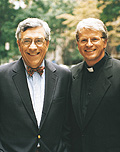One of my great teachers has just died.
I know: you would expect me to name a particularly profound rabbi, or a great Jewish theologian.
But today, you would be wrong.
Today I am remembering the life of Monsignor Thomas Hartman, of the Diocese of Rockville Centre, NY, whom God called home at the age of 69. Father Hartman had been suffering from Parkinson’s disease, and he fought nobly until the very end.
I first came to know Father Hartman through my close friendship with Rabbi Marc Gellman, who, along with Father Hartman, comprised “The God Squad.” “The God Squad” was a long running television show, which began on the Telicare network on Long Island. Their teamwork then went national (including regular appearances on “The Don Imus Show” and “Good Morning America”). They had a national syndicated newspaper column. They wrote a book together, which became an HBO special. I had the great privilege to be a guest on “The God Squad” on many occasions over the years, and I grew immeasurably from the experience.
Monsignor Thomas Hartman was smart, handsome, articulate — an “aw shucks” kind of guy whose demeanor belied a national, and even international, reach and influence.
Tom and Marc had one mission: to model that a rabbi and a priest could be friends — and that, beyond that, our respective faiths could be friends.
When I first met Tom Hartman, some twenty-five years ago on Long Island, we spent the day together.
On that day, I learned things about the religious life that I had never known before.
The first lesson. Rather than go out to eat at a restaurant, Tom suggested that we go to his parents’ home for lunch. Why? He had not seen them in a few weeks, and he wanted to check in on them.
The takeaway: The fifth commandment is to “Honor your parents.” Tom Hartman was one of the busiest priests in the “business,” and his office desk, insanely piled with papers and projects, testified to that.
But Tom knew that all of his busy-ness, and even sacred work, meant nothing without his attention to the holiest work that a person can do: paying attention to one’s parents.
The second lesson. We arrived at the Hartman home, which was located on a plain, post-war block in a working-class neighborhood on Long Island. Mrs. Hartman greeted me as if I were a long lost relative. She ushered us into their small kitchen, and then she proceeded to serve us lunch.
Here is the scene. Mrs. Hartman is scooping a casserole onto our plates.
Mrs. Hartman: Now, Tommy, what did you say that your friend does for a living?
Tom: He’s a rabbi, Mom. So, about the casserole….
A piece of casserole was already dropping from the large spoon in her hand, and it was beginning its descent onto my plate.
But, Mrs. Hartman pulls a slight of hand. She pushes my plate out of the way, catches the piece of casserole on her spoon, returns it to the serving dish, and says: “Ah. No problem. I also have some tuna fish for your friend.”
The casserole had contained ham. Tom realized that, and without my saying so (and he had just met me), realized that a food faux pas was about to happen. Just in the nick of time, Mrs. Hartman intercepted the culinary work of her hands, and saved the day.
The takeaway: Tom Hartman discerned, without my even telling him, and without even knowing e, that because I was a Jew and a rabbi, there was a strong possibility that I observed the biblical dietary laws.
He was right. And, in a great act of interfaith sensitivity, he prevented me from violating that tradition.
From this, we learn that one of the true marks of an interfaith friendship is to not only know the other’s traditions, and not only to respect them — but to do everything possible to help that friend stay true to who they really are.
(I compare Mrs. Hartman’s faithful gesture, sadly, to the many Jews who believe that keeping kosher is a mere artifact of the past that can be easily and cavalierly discarded.)
The third lesson. We finish lunch at the Hartman residence, and Tom tells me that he has to stop off at his own home to pick something up.
We drove to a large Catholic high school. We entered the school, with various kids giving the Monsignor a high five, and we took an elevator to the fifth floor of the school building.
That was where Tom Hartman lived. On the fifth floor of a high school. In a small apartment. With several other priests.
The takeaway. Here was a priest of the church, a monsignor, a television personality, a man who was on a first name basis with political figures and international leaders.
He had apartment mates.
It’s called humility.
The contemporary sage, Abraham Joshua Heschel, once referred to “our teachers in heaven.”
Msgr. Hartman was one of my great teachers.
And he is now in heaven. May God watch over him.






